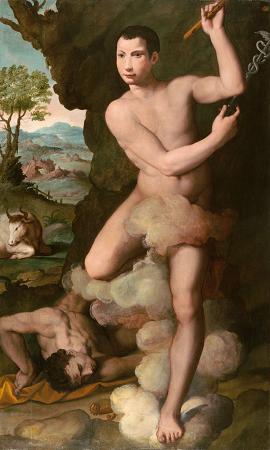Caduceus. The caduceus is the staff carried by Hermes in Greek mythology and consequently by Hermes Trismegistus in Greco-Egyptian mythology. The same staff was also borne by heralds in general, for example by Iris, the messenger of Hera. It is a short staff entwined by two serpents, sometimes surmounted by wings. In Roman iconography, it was often depicted being carried in the left hand of Mercury, the messenger of the gods, guide of the dead, and protector of merchants, shepherds, gamblers, liars, and thieves. Some accounts suggest that the oldest known imagery of the caduceus has its roots in a Mesopotamian origin with the Sumerian god Ningishzida; whose symbol, a staff with two snakes intertwined around it, dates back to 4000 BC to 3000 BC. As a symbolic object, it represents Hermes, and by extension trades, occupations, or undertakings associated with the god. In later Antiquity, the caduceus provided the basis for the astrological symbol representing the planet Mercury. Thus, through its use in astrology, alchemy, and astronomy it has come to denote the planet and elemental metal of the same name. It is said the wand would wake the sleeping and send the awake to sleep. If applied to the dying, their death was gentle; if applied to the dead, they returned to life. By extension of its association with Mercury and Hermes, the caduceus is also a recognized symbol of commerce and negotiation, two realms in which balanced exchange and reciprocity are recognized as ideals. This association is ancient, and consistent from the Classical period to modern times. The caduceus is also used as a symbol representing printing, again by extension of the attributes of Mercury. The caduceus is often incorrectly used as a symbol of healthcare organizations and medical practice, particularly in the United States of America, due to confusion with the traditional medical symbol, the Rod of Asclepius, which has only one snake and is never depicted with wings. Further information: Serpent worship The term kerukeion denoted any herald's staff, not necessarily associated with Hermes in particular. In his study of the cult of Hermes, Lewis Richard Farnell assumed that the two snakes had simply developed out of ornaments of the shepherd's crook used by heralds as their staff. This view has been rejected by later authors pointing to parallel iconography in the Ancient Near East. It has been argued that the staff or wand entwined by two snakes was itself representing a god in the pre-anthropomorphic era. Like the herm or priapus, it would thus be a predecessor of the anthropomorphic Hermes of the classical era. William Hayes Ward discovered that symbols similar to the classical caduceus sometimes appeared on Mesopotamian cylinder seals. He suggested the symbol originated some time between 3000 and 4000 BC, and that it might have been the source of the Greek caduceus. A.L. Frothingham incorporated Dr. Ward's research into his own work, published in 1916, in which he suggested that the prototype of Hermes was an Oriental deity of Babylonian extraction represented in his earliest form as a snake god. From this perspective, the caduceus was originally representative of Hermes himself, in his early form as the Underworld god Ningishzida, messenger of the Earth Mother.The caduceus is mentioned in passing by Walter Burkert as really the image of copulating snakes taken over from Ancient Near Eastern tradition. In Egyptian iconography, the Djed pillar is depicted as containing a snake in a frieze of the Dendera Temple complex. In the biblical Books of Kings, the Nehushtan is a derogatory name given to a bronze serpent on a pole first described in the Book of Numbers which God told Moses to erect so that the Israelites who saw it would be protected from dying from the bites of the fiery serpents, which God had sent to punish them for speaking against Him and Moses. The caduceus also appears as a symbol of the punch-marked coins of the Maurya Empire in India, in the third or second century BC. Numismatic research suggest that this symbol was the symbol of the Buddhist king Ashoka, his personal Mudra. This symbol was not used on the pre-Mauryan punch-marked coins, but only on coins of the Maurya period, together with the three arched-hill symbol, the peacock on the hill, the triskelis and the Taxila mark.It also appears carved in basalt rock in few temples of western ghats. The Homeric hymn to Hermes relates how Hermes offered his lyre fashioned from a tortoise shell as compensation for the cattle he stole from his half brother Apollo. Apollo in return gave Hermes the caduceus as a gesture of friendship.
more...







